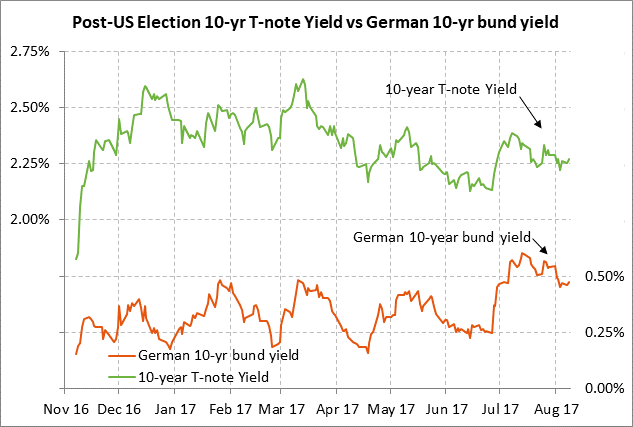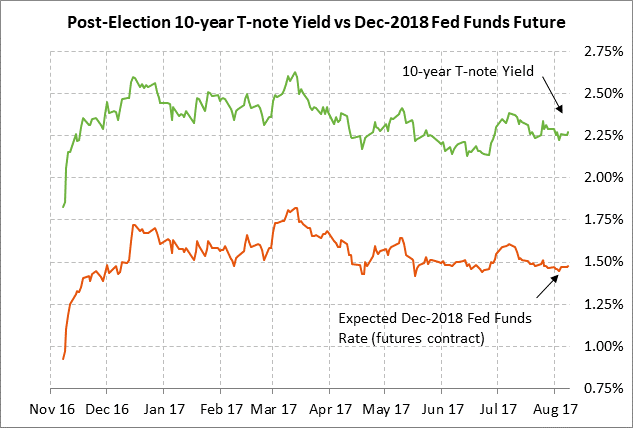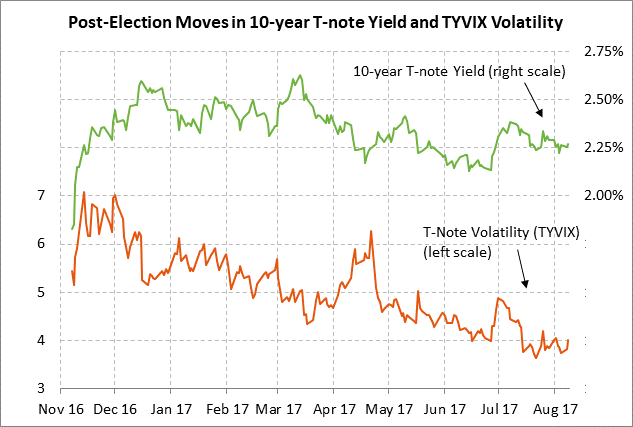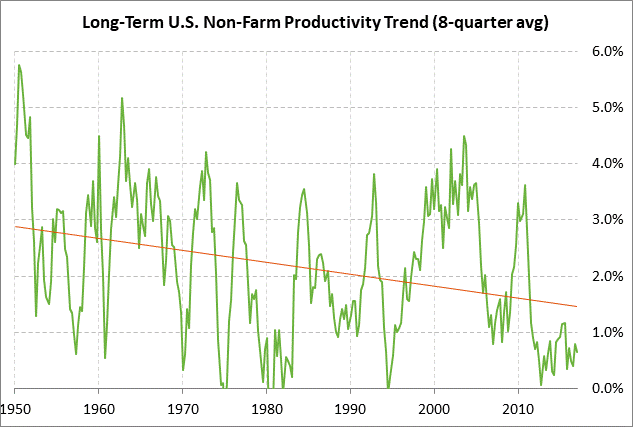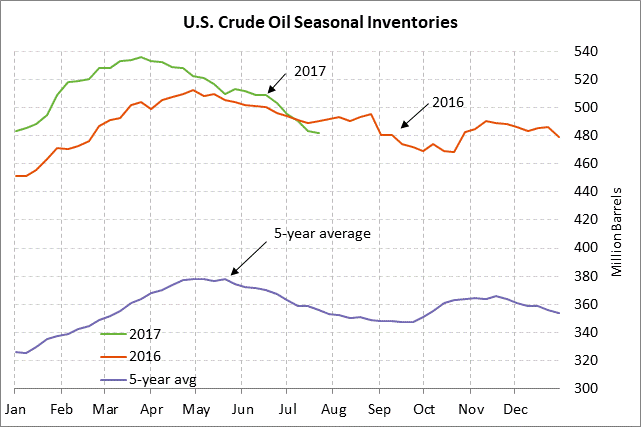- T-note yields trade sideways ahead of bigger events in September
- 10-year T-note auction to yield near 2.27%
- Markets start to take North Korean situation more seriously
- U.S. productivity expected to remain poor
- Weekly EIA report
T-note yields trade sideways ahead of bigger events in September — The 10-year T-note yield has settled into a narrow trading range pattern over the past three weeks, awaiting any fresh market-moving developments. The 10-year T-note yield rose sharply following ECB President Draghi’s hawkish speech in Sintra, Portugal on June 27, which sparked an upward spike in Eurozone bond yields. However, T-note yields fell back through mid-July, along with bund yields, as ECB members insisted that they have not yet had active discussions about ending their QE program. U.S. T-note yields have also fallen back due to generally dovish Fed comments tied to the soft U.S. inflation statistics, which have reduced expectations to 56% for a Fed rate hike by year-end.
The TYVIX on Tuesday showed a small pop to a 1-week high of 4.00 on President Trump’s North Korean threat, but T-note implied volatility is still trading at depressed levels as the market moves sideways. This Friday’s July CPI report could spark a market move if it diverges significantly from market expectations for a rise to +1.8% from June’s +1.6% (July core CPI expected unchanged from June’s +1.7% y/y). In addition, next Tuesday’s U.S. July retail sales report (expected +0.4%) or Wednesday’s July 25-26 FOMC meeting minutes could spark some T-note price movement.
However, the prospects look dim for any big T-note price moves in August as the market looks ahead to what could be a more volatile September. The ECB at its Sep 7 meeting may announce QE tapering for 2018. The Fed at its Sep 19-20 meeting is considered likely to announce a start date for its balance sheet normalization program, which may begin as soon as Oct 1. Congress during September will be under the gun to approve (1) new spending authority to keep the U.S. government open past Oct 1, and (3) a debt ceiling hike by early to mid-October to keep the Treasury from defaulting. Republicans in September are also due to unveil their tax cut plan.
10-year T-note auction to yield near 2.27% — The Treasury today will sell $23 billion of 10-year T-notes in a new issue, as opposed to a reopening. The Treasury will then conclude this week’s $62 billion refunding operation by selling $15 billion of 30-year T-bonds on Thursday.
Today’s new 10-year T-note issue was trading at 2.27% in when-issued trading late Tuesday afternoon. That translates to an inflation-adjusted yield of 0.44% against the current 10-year breakeven rate of 1.83%. The 12-auction averages for the 10-year are as follows: 2.45 bid cover ratio, $16 million in non-competitive bids, 5.5 bp tail to the median yield, 14.8 bp tail to the low yield, and 28% taken at the high yield.
The 10-year T-note is the fourth most popular coupon security among foreign investors and central banks, behind the 10-year TIPS, 30-year TIPS and 7-year T-note. Indirect bidders, a proxy for foreign buyers, have taken an average of 63.8% of the last twelve 10-year T-note auctions, which is moderately above the average of 60.6% for all recent Treasury coupon auctions.
Markets start to take North Korean situation more seriously — The U.S. stock market on Tuesday fell and the VIX shot up by +1.03 points to 10.96% (from Monday’s close of 9.93) after President Trump said that North Korea will be “met with fire and fury and, frankly, power the likes of which the world has never seen before” if Kim Jong Un continues to make threats against the U.S.
President Trump made his threat after news earlier in day that North Korea is now technically capable of miniaturizing nuclear weapons that can fit on missile, which was a big step forward in North Korea’s ability to credibly threaten the U.S. mainland with a nuclear-tipped ICBM missile.
There is virtually no chance for a preventative U.S. military strike against North Korea because of the mass casualties that would result from a North Korean counter-strike against South Korea and possibly Japan and because China could respond to the U.S. with military action of its own. However, President Trump needs to convince China that he is serious about military action in order to get China to clamp down harder on its client, which means that Mr. Trump’s rhetoric needs to be taken with a grain of salt.
Nevertheless, as U.S. and North Korea step up their threats, the risks grow for a provocation or misunderstanding that could lead to an actual military conflict. The markets in any case are now taking the North Korean situation more seriously. Tuesday’s events showed that negative North Korea news is now more likely to move the markets going forward.
U.S. productivity expected to remain poor — The market consensus is for today’s U.S. Q2 non-farm productivity report to show an increase of +0.7% (q/q annualized), helped by the relatively strong Q2 GDP of +2.6%. However, the expected +0.7% productivity increase would be far below the post-war average of +2.2%. The expected report would provide more evidence that the U.S. has a serious long-term productivity problem that is holding back real wages and undercutting corporate profits. U.S. productivity since 2012 has shown its worst sustained performance in post-war history.
Weekly EIA report — The market consensus for today’s weekly EIA report is for a -2.1 million bbl drop in U.S. crude oil inventories, a -1.75 million bbl drop in gasoline inventories, a -500,000 bbl drop in distillate inventories, and a -0.5 point decline in the refinery utilization rate to 94.9%.

